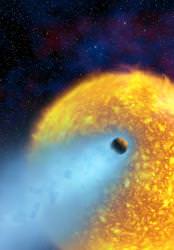To destroy a terrestrial planet, you need the Death Star. But what will you do if you want to take out a gas giant? No mere superlaser is going to get the job done. But if you can get the gas giant close enough to its parent star, you should just be able to make it evaporate. How close? According to researchers from University College London, get a planet twice as close as Mercury to its parent star and it’s a goner (in a few billion years).
But whoa you say, haven’t astronomers found planets orbiting well within this distance? They certainly have. In fact, HD 209458b is 70% the mass of Jupiter and orbits its parent star about 12% the orbital distance of Mercury. And it’s evaporating as we speak.
Okay fine, it doesn’t destroy a planet in such a spectacular fashion as blasting it with a superlaser, but you can rest assured, its fate is sealed. Queue the maniacal laughter…
The research was carried out by Tommi Koskinen from University College London, and published in this week’s edition of the journal Nature.
According to Koskinen and his colleage, Professor Alan Aylward, they used some sophisticated new modeling tools to get at their calculations. They used 3D-modeling techniques to see the whole heating process as the planet gets closer to the parent star. Their model includes the powerful supersonic cooling winds that have been detected on other planets.
Within 0.15 astronomical units of the star is the point of no return for a gas planet. Within this radius and molecular hydrogen in its atmosphere becomes unstable and temperature regulating processes become overwhelmed. The planet’s atmosphere then begins to heat up uncontrollably.
Temperatures on the planet will rise from 3,000 degrees Celsius to more than 20,000 degrees. At this point its atmosphere begins boiling off into space.
It’s not a quick process. Planets at this distance will start losing material very slowly, and will probably still survive for billions of years.
You’ll have to be a very patient evil space emperor to destroy gas giants this way.
Original Source: UCL News Release


so if we can’t burn up the gas giant with our super laser, we’d just use our super tractor beam to tow it closer to the sun. No problem.
(re: queueing) Great idea to put the maniacal laughter in line to be done at a later time (ie when HD 209458b is finally kaput) as opposed to immediately cueing the laughter. You’re right: it just seems premature.
Other methods we can’t use to destroy a gas giant:
1. Light a match underneath it.
2. Fill it with several million 1x3x9 black monoliths.
3. Put it on a high-fiber diet.
Or, we could just simulate just such an event in Garry’s Mod or a similar physics simulation! (i.e. evaporating a gas giant!)
Cheeseburgers are supposed to be REALLY bad! Maybe we should try that? 😀
Erm, am I the only one thinking the really obvious here? Why not just put the gas giant IN the star? No more waiting billions of years!
I wonder what peril any of the gas giants pose to us. I wonder why we’d waste the money, time and energy to study destroying such a planet. I wonder if I’m alone wondering this. I wonder.
IPuring Hypothetical question . Looks like Macho kiku’s idea of a type of civilization
using Gas gaints for thier energy utilization purposes.
I feel scared when i think about a gas giant coming to destroy our earth.I wonder if there is a machine to destroy it. I am studying hard and I wish that there could be a way to cope with it.